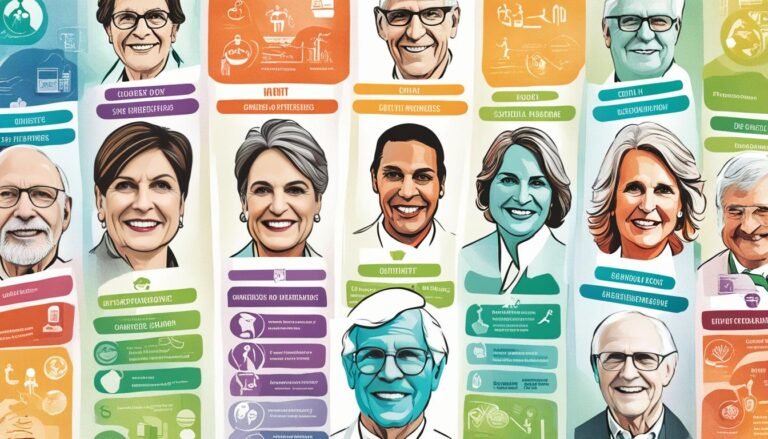Crafting Digital Patient Experiences That Resonate and Engage
In today’s digital age, where patients are bombarded with information and options, crafting digital patient experiences that truly resonate and engage has become a paramount task for healthcare providers.
The power of technology to connect, educate, and empower patients cannot be overstated. By leveraging user-friendly websites, mobile apps, and personalized communication, healthcare organizations can enhance patient satisfaction, loyalty, and ultimately improve outcomes.
In this article, we will explore the innovative strategies and tools that are transforming the landscape of digital healthcare delivery and patient engagement.
Key Takeaways
- Digital patient experiences revolutionize healthcare delivery and improve outcomes.
- Personalizing patient digital experiences caters to individual preferences and provides tailored information and support.
- Overcoming digital communication barriers ensures easy access and understanding of information.
- Leveraging technology, such as telehealth services and mobile applications, enhances patient engagement.
The Importance of Digital Patient Experiences
In today’s healthcare landscape, the importance of digital patient experiences cannot be overstated. Digital patient experiences have the potential to revolutionize the way healthcare is delivered and received, ultimately improving patient outcomes and enhancing patient empowerment.
By leveraging technology, healthcare providers can offer patients personalized, accessible, and convenient care. Through digital platforms, patients can easily access their medical records, schedule appointments, and communicate with their healthcare team, leading to improved patient outcomes. With the ability to access their health information at their fingertips, patients are better equipped to actively participate in their own care, resulting in more informed decision-making and better health management.
Digital patient experiences also play a crucial role in enhancing patient empowerment. By providing patients with tools and resources to track their health and make informed decisions, healthcare organizations empower patients to take control of their well-being. Through patient portals and mobile health apps, patients can monitor their vitals, track progress towards their health goals, and receive personalized health recommendations. This level of engagement and empowerment fosters a sense of ownership over one’s health, leading to increased patient satisfaction and improved overall outcomes.
Understanding Patient Needs in the Digital Age
Understanding the needs of patients in the digital age is crucial for crafting effective and engaging digital experiences.
Personalizing patient digital experiences allows healthcare providers to cater to individual preferences and provide tailored information and support.
Additionally, overcoming digital communication barriers ensures that patients can easily access and understand the information they need, fostering greater engagement and satisfaction with digital healthcare platforms.
Personalizing Patient Digital Experiences
Effective personalization of patient digital experiences requires a deep understanding of their specific needs in the digital age. With the advancements in technology, it is crucial to cater to patients in a way that resonates with them on a personal level. Here are three key reasons why increasing personalization and improving connectivity in patient digital experiences is essential:
-
Empathy: By understanding patients’ unique circumstances and challenges, personalized digital experiences can show empathy and provide relevant support.
-
Trust-building: Personalization fosters a sense of trust, as patients feel heard and understood, leading to stronger patient-provider relationships.
-
Engagement: Customizing digital experiences based on patients’ preferences and needs increases their engagement, making them more likely to actively participate in their healthcare journey.
Overcoming Digital Communication Barriers
Digital communication barriers can hinder the effective fulfillment of patient needs in the modern era. As technology continues to evolve, it is crucial to overcome these barriers and improve patient communication.
One of the key challenges is the complexity of technology itself. Many patients may struggle to navigate digital platforms or understand the information presented to them. To address this, healthcare providers should invest in user-friendly interfaces and provide clear instructions to guide patients through the digital experience.
Additionally, language barriers can further complicate communication. By offering multilingual options and translation services, healthcare organizations can ensure that patients can understand and engage with the information provided.
Overcoming these technology barriers is essential to creating a seamless and user-centric digital experience that meets the diverse needs of patients.
Leveraging Technology for Patient Engagement
Utilizing technology to enhance patient engagement is crucial for healthcare organizations looking to improve the overall patient experience. With the rapid advancement of technology in healthcare, there are numerous ways to leverage its power to foster better communication and engagement between patients and healthcare providers.
Here are three ways technology can improve patient communication and engagement:
-
Telehealth: Telehealth services allow patients to connect with healthcare providers remotely, eliminating the need for in-person visits. This not only saves patients time and travel expenses but also enables them to access healthcare services from the comfort of their own homes. This convenience can greatly enhance patient engagement, as it removes barriers to accessing care.
-
Mobile Applications: Mobile applications provide patients with a convenient platform to access their health information, schedule appointments, and communicate with healthcare providers. These apps can also provide personalized health tips and reminders, empowering patients to take an active role in their healthcare journey.
-
Patient Portals: Patient portals give patients secure online access to their medical records, test results, and treatment plans. By providing patients with easy access to their health information, healthcare organizations can improve patient communication and engagement. Patients can review their records, ask questions, and actively participate in shared decision-making with their healthcare providers.
Designing User-Friendly Websites and Mobile Apps
With a focus on usability and functionality, healthcare organizations can create user-friendly websites and mobile apps that enhance the digital patient experience. User experience design plays a crucial role in ensuring that patients can easily navigate and engage with these platforms. By incorporating intuitive layouts, clear navigation menus, and user-friendly features, healthcare organizations can provide patients with a seamless and enjoyable digital experience.
When it comes to mobile app development, healthcare organizations need to prioritize simplicity and convenience. Mobile apps should be designed to be intuitive and easy to use, with a clear and concise interface. Patients should be able to access their medical records, schedule appointments, and communicate with healthcare providers effortlessly. Additionally, features such as reminders and push notifications can help keep patients engaged and informed about their healthcare journey.
In terms of website design, healthcare organizations should focus on creating a visually appealing and user-centric experience. This includes using responsive design to ensure that the website is accessible on different devices, as well as optimizing loading times for a smooth browsing experience. Furthermore, incorporating features such as online appointment booking and patient portals can enhance convenience and engagement for patients.
Personalizing Communication for Better Patient Connection
When it comes to healthcare, personalized communication is key to creating a strong connection with patients.
By tailoring patient interactions, healthcare providers can better understand their patients’ needs and preferences, leading to enhanced patient engagement.
This personalized approach not only fosters trust and loyalty, but also allows for more effective communication and improved health outcomes.
Tailoring Patient Interactions
Patient interactions can be tailored to enhance communication and establish a stronger connection with the individual. By personalizing communication, healthcare providers can improve patient communication and optimize the overall patient experience.
Here are three ways to evoke emotion and create a more meaningful connection with patients:
-
Show empathy: Understanding and empathizing with the patient’s emotions and concerns can help build trust and foster a supportive environment.
-
Use personalized language: Addressing patients by their preferred name and using clear, jargon-free language can make them feel valued and understood.
-
Active listening: Attentively listening to patients’ needs and concerns shows that their voice is being heard and respected.
Enhancing Patient Engagement
To create a more meaningful and connected experience, healthcare providers can enhance patient engagement by personalizing communication.
Improving communication is crucial in fostering patient empowerment and building a strong patient-provider relationship. By tailoring communication to individual patients, healthcare providers can address their specific needs, concerns, and preferences effectively.
Personalized communication can take various forms, such as using plain language, providing information in the patient’s preferred language or format, and using digital tools for convenient and timely communication. This approach helps patients feel heard, understood, and valued, ultimately leading to better engagement and outcomes.
When patients are actively engaged in their healthcare journey, they are more likely to adhere to treatment plans, make informed decisions, and take an active role in managing their health.
Utilizing Virtual Consultations for Convenient Care
Leveraging virtual consultations enables healthcare providers to offer accessible and streamlined care to patients. With the advancement of telemedicine platforms, patients can now have virtual follow-up appointments with their healthcare providers from the comfort of their own homes. This convenient and efficient approach to care has several benefits:
-
Increased accessibility: Virtual consultations eliminate geographical barriers, allowing patients in remote areas or with limited mobility to receive medical advice and treatment without the need for travel.
-
Time-saving: Patients no longer have to spend hours commuting to and waiting in crowded waiting rooms. Virtual consultations enable them to receive timely care without disrupting their daily routine.
-
Enhanced patient experience: By providing a virtual consultation option, healthcare providers show empathy and understanding towards their patients’ busy schedules and commitments. This fosters a positive patient-provider relationship and improves patient satisfaction.
Enhancing Patient Education and Empowerment Through Digital Tools
Digital tools have the potential to revolutionize patient education and empowerment by offering interactive educational content, personalized health resources, and real-time patient feedback.
These tools allow patients to actively engage with their healthcare journey, enabling them to make informed decisions and take control of their own health.
Interactive Educational Content
Enhancing patient education and empowerment is achievable through the use of interactive educational content. By incorporating interactive learning and online tutorials into digital tools, patients can have a more engaging and personalized learning experience. This not only helps them understand their health conditions better but also empowers them to take an active role in managing their own well-being.
To evoke emotion in the audience, consider the following sub-lists:
-
Improved understanding: Interactive educational content allows patients to visualize complex medical concepts, making it easier for them to comprehend their conditions and treatment options. This can alleviate anxiety and instill confidence in patients, promoting a sense of empowerment.
-
Personalization: Interactive tools can be customized to suit individual needs, ensuring that patients receive information that is relevant to their specific circumstances. This personal touch fosters a sense of empathy and connection, enhancing the overall patient experience.
-
Empowerment through self-paced learning: Online tutorials enable patients to learn at their own pace, thereby improving their retention and understanding of medical information. This autonomy empowers patients to make informed decisions and take control of their health journey.
Personalized Health Resources
Patients can benefit greatly from personalized health resources, as they provide tailored information and tools that enhance their education and empowerment in managing their own healthcare through digital platforms.
Customized wellness programs and personalized treatment plans are crucial in addressing the unique needs and preferences of each patient. By utilizing digital tools, healthcare providers can deliver targeted resources that cater to specific conditions, lifestyles, and goals.
These resources can include interactive educational content, virtual coaching, and self-assessment tools, all designed to empower patients to take an active role in their healthcare journey.
Through personalized health resources, patients can access relevant and reliable information, track their progress, and make informed decisions about their well-being. This level of customization not only improves patient engagement and satisfaction but also promotes better health outcomes.
Real-Time Patient Feedback
A significant number of healthcare providers are utilizing real-time patient feedback to enhance patient education and empowerment through the use of digital tools. This innovative approach allows healthcare professionals to gather immediate feedback from patients, enabling them to make real-time adjustments to their treatment plans and improve the overall patient experience.
Here are three ways in which real-time patient feedback is revolutionizing healthcare:
-
Real-time patient monitoring: By collecting data on patients’ vital signs, symptoms, and treatment adherence in real-time, healthcare providers can identify any potential issues or complications promptly. This allows for timely interventions and proactive management of patients’ health, leading to better outcomes.
-
Patient experience optimization: Real-time patient feedback allows healthcare providers to understand patients’ needs and preferences better. By actively listening to patients’ experiences, healthcare professionals can tailor their services to meet individual expectations, resulting in increased patient satisfaction and engagement.
-
Empowerment through digital tools: Real-time patient feedback empowers patients by giving them a voice in their healthcare journey. Digital tools, such as patient portals and mobile applications, enable patients to provide feedback, ask questions, and actively participate in their treatment plans. This collaborative approach fosters a sense of empowerment and ownership over one’s health.
Promoting Patient Satisfaction and Loyalty Through Digital Experiences
One effective way to promote patient satisfaction and loyalty is by leveraging digital experiences. By implementing patient engagement strategies and focusing on the digital customer experience, healthcare providers can create a more personalized and convenient journey for their patients.
Digital experiences enable healthcare providers to connect with patients in a more efficient and meaningful way. Through various digital platforms such as patient portals, mobile apps, and telemedicine services, patients can easily access their medical information, schedule appointments, communicate with healthcare providers, and even receive remote medical care. This convenience and accessibility enhance patient satisfaction by reducing wait times, improving communication, and empowering patients to take control of their healthcare.
To further illustrate the impact of digital experiences on patient satisfaction and loyalty, consider the following table:
| Benefits of Digital Experiences for Patients |
|---|
| Convenient access to medical information and services |
| Improved communication with healthcare providers |
| Reduced wait times and increased efficiency |
| Empowerment to manage their healthcare journey |
By offering these benefits, healthcare providers can foster positive patient experiences, leading to increased satisfaction and loyalty. Additionally, digital experiences allow providers to gather valuable feedback and data, enabling them to continuously improve their services and tailor them to meet the specific needs of their patients.
Measuring the Impact of Digital Patient Experiences
How can the impact of digital patient experiences be measured?
When it comes to measuring the effectiveness of digital patient experiences, tracking outcomes is crucial. Here are three key ways to measure the impact:
-
Surveys and Feedback: Directly asking patients about their experience through surveys and feedback forms can provide valuable insights into their satisfaction level. By asking specific questions about their interaction with digital tools and platforms, healthcare providers can gauge the effectiveness of these experiences.
-
User Analytics: Tracking user behavior on digital platforms can help measure engagement and identify areas for improvement. Analyzing metrics like click-through rates, time spent on pages, and conversion rates can provide a quantitative understanding of how patients are interacting with digital experiences.
-
Patient Outcomes: Ultimately, the success of digital patient experiences should be measured by their impact on patient outcomes. This can include factors like improved health outcomes, increased medication adherence, reduced hospital readmissions, and enhanced patient empowerment.
Innovations in Digital Healthcare Delivery and Patient Engagement
Continuously evolving digital healthcare delivery and patient engagement techniques drive innovation in the healthcare industry. With the rapid advancement of digital health technology, healthcare providers are finding new ways to improve patient outcomes and enhance patient engagement.
One such innovation is remote patient monitoring, which allows healthcare professionals to monitor patients’ health conditions from a distance. Digital health technology, including wearable devices and mobile applications, enables patients to track their vital signs, medication adherence, and lifestyle habits. This data can be securely transmitted to healthcare providers, who can then analyze it and provide personalized recommendations and interventions. Remote patient monitoring not only empowers patients to take an active role in managing their health but also allows healthcare providers to intervene early and prevent complications.
Moreover, remote patient monitoring enhances patient engagement by enabling real-time communication between patients and healthcare providers. Through telehealth visits, patients can consult with their healthcare providers from the comfort of their homes, saving time and travel expenses. This level of convenience promotes regular follow-ups and improves patient adherence to treatment plans.
Conclusion
In conclusion, crafting digital patient experiences that resonate and engage is crucial in today’s digital age. By understanding patient needs and leveraging technology, healthcare providers can design user-friendly websites and mobile apps that personalize communication, enhance patient education, and promote satisfaction and loyalty.
Measuring the impact of these digital experiences is essential to continuously improve healthcare delivery. As the saying goes, ‘The patient’s experience is the best teacher.’ Let us strive to create empathetic, informative, and user-centric digital patient experiences that truly make a difference.





